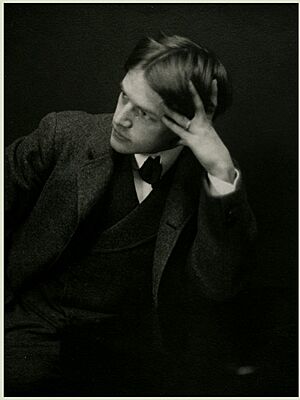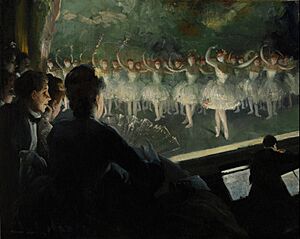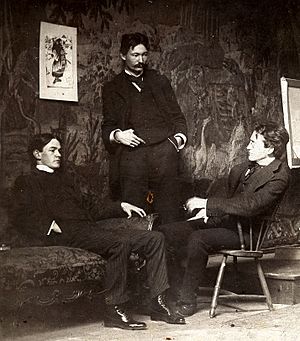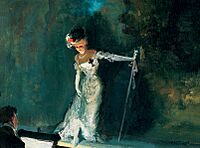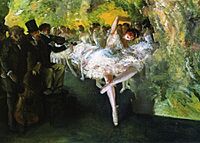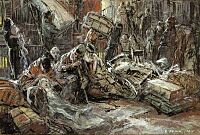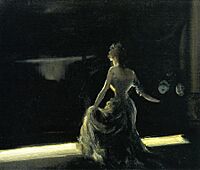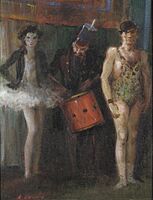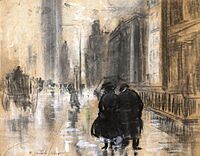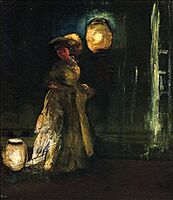Everett Shinn facts for kids
Quick facts for kids
Everett Shinn
|
|
|---|---|
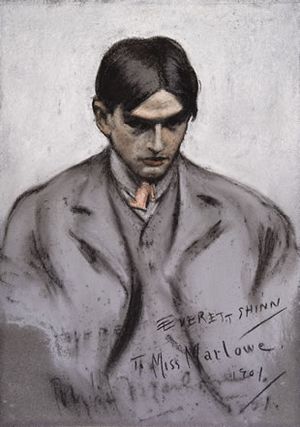
Self-portrait done in 1901 in his charcoal style
|
|
| Born | November 6, 1876 Woodstown, New Jersey, U.S.
|
| Died | May 1, 1953 (aged 76) New York City, U.S.
|
| Known for | Painting, set design |
| Movement | Modernism, realism |
Everett Shinn (November 6, 1876 – May 1, 1953) was an American painter. He was part of a group of artists called the Ashcan School. These artists liked to paint scenes of everyday city life.
Shinn started his career drawing for newspapers in Philadelphia. He was very good at showing movement in his drawings. Later, he joined other artists like William J. Glackens, George Luks, and John Sloan. They were all part of the Ashcan School, led by Robert Henri. This group wanted to paint real life, not just pretty pictures. Shinn is famous for his paintings of city scenes, like disasters or street fights. He also loved to paint the theater, seeing it as a place of exciting illusions. Shinn was special because he often used pastels, a type of colored chalk, for his art.
Contents
Early Life and Art Beginnings
Everett Shinn was born in Woodstown, New Jersey. His parents, Isaiah and Josephine Shinn, were farmers. From a young age, it was clear that Everett had a talent for drawing.
When he was 15, Shinn went to the Spring Garden Institute in Philadelphia to study mechanical drawing. The next year, he took art classes at the Pennsylvania Academy of the Fine Arts. By age 17, he was working as an artist for the Philadelphia Press newspaper.
In 1897, Shinn moved to New York City. He quickly became known for painting the busy energy and different parts of modern city life. In 1898, he married Florence "Flossie" Scovel, who was also an artist. They later divorced in 1912. Shinn continued to paint throughout his life. He passed away in New York City in 1953 from lung cancer.
Becoming a Professional Artist
Many art experts, and Shinn himself, believe his job at the Philadelphia Press was the real start of his art career. He was a very skilled artist at a time when newspapers relied on drawings. Shinn later felt sad that photography started to replace drawings in newspapers.
His ability to show movement and pay attention to details in his newspaper drawings also showed up in his paintings. In 1899, he stopped working for newspapers and started illustrating for magazines like Ainslee's Magazine. Over the next twenty years, he drew for many popular magazines, including Harper's, Vanity Fair, and Life.
Shinn also began showing his paintings and pastels to the public in 1899. In 1900, he and Flossie traveled to Europe. This trip helped him study other painters and prepare for more art shows. He was especially interested in Impressionism and European art that showed the theater.
Shinn once said about his time at the Philadelphia Press:
"In the Art Department of the Philadelphia Press... William Glackens, George Luks, Everett Shinn and John Sloan went to school... a school that trained memory and quick perception."
While in Philadelphia, artists Robert Henri, John Sloan, and Joseph Laub started the Charcoal Club. This was an informal art school where artists could share their work and ideas. The group included Henri, Sloan, Shinn, Glackens, and Luks. This club is often seen as the beginning of the Ashcan School. Henri encouraged younger artists to look at the modern city for their subjects. He wanted them to paint in a freer, less formal style, and Shinn agreed with this idea.
New York City and The Eight
In 1897, Shinn got a better-paying job as an illustrator for Joseph Pulitzer's New York World newspaper. Other members of the Charcoal Club soon joined him in New York. Shinn loved living in the city and watching the busy life of Manhattan. His paintings like Fire on Mott Street and Fight show how much he was fascinated by city life. He was especially interested in dramatic scenes like accidents or street violence. His favorite art material for these scenes was pastel. He is the only Ashcan artist who created many works using pastels.
When Shinn was in Europe, he likely saw the work of artists like Daumier, Degas, and Lautrec in France, and Walter Sickert in England. You can see their influence in Shinn's art, especially in his paintings of theater stages. Some of his paintings, like Trapeze, Winter Garden, New York (1903), show performers from the back of the stage. Others, like London Hippodrome (1902), show the stage from high up in a balcony. Shinn spent a lot of time at the theater. He painted ballet dancers, magicians, actors, and acrobats. He showed how exciting and lively performance art was for both the performers and the audience.
Shinn became friends with important theater people in New York, like playwright Clyde Fitch and producer David Belasco. These connections helped him meet wealthy people in Manhattan. As a result, Shinn painted many murals for homes designed by famous architects like Stanford White. His most important murals, which have been restored, are in Belasco's Stuyvesant Theatre (now the Belasco Theatre). This theater opened in 1907 and is still a famous Broadway playhouse.
In February 1908, Shinn showed his art in a special exhibition at the Macbeth Galleries in New York. This show was a protest against the old-fashioned art rules of the National Academy of Design. The exhibition, which traveled to several cities, brought a lot of attention to the Ashcan painters. The artists in this show were known as The Eight. This group included five realists (Shinn, Henri, Sloan, Glackens, and Luks) and three other artists who painted in a more impressionistic style. Among Shinn's paintings in this show was The London Hippodrome (1902), which is one of his most famous works.
Later Years and Legacy

Unlike other members of The Eight, Shinn did not show his art in the famous 1913 Armory Show of modern art. In fact, he didn't like modern art styles like those of Picasso and Matisse. He continued to paint in a realistic style throughout his life. This is one reason why his place in art history became less prominent after his death. Some people felt his later art became more commercial. For example, the murals he painted for the Plaza Hotel bar in the 1940s showed old-fashioned scenes of city streets.
Shinn didn't exhibit his paintings much between 1910 and 1937. However, in 1937, his work was included in the Whitney Museum's "New York Realists" show. In the 1940s, his art was shown in more museum exhibitions. Just before he died, a respected gallery in New York, James Graham & Sons, began representing his work. While he had successful years and owned large homes, he faced financial difficulties later in life.
Everett Shinn was the youngest member of The Eight. His art is unique and doesn't always fit perfectly into one category. However, he is usually remembered as part of The Eight and the Ashcan School.
Shinn's relationships with the other members of The Eight were not always strong. Some, like John Sloan, felt that Shinn's interest in a fancy lifestyle and interior decorating didn't fit with their focus on real city life. But Shinn never claimed his art was political. His best works capture a part of American city life in the early 1900s. His most ambitious paintings, like The London Hippodrome and The Orchestra Pit: Old Proctor's Fifth Avenue Theater, are considered some of the greatest theater-inspired artworks in American art.
Images for kids
Gallery
-
Winter on 21st Street, New York 1889 – Brooklyn Museum
-
Fifth Avenue, 1910 – Brooklyn Museum
Selected Works
- Fifth Avenue Coach, Winter (1906): Montclair Art Museum
- Backstage Scene (1900): Delaware Art Museum
- Tenements at Hester Street (1900): The Phillips Collection, Washington, D.C.
- Self-Portrait (1901): National Portrait Gallery, Washington, D.C.
- The Hippodrome, London (1902): Art Institute of Chicago, Chicago
- The Vaudeville Act (1902–1903): Palmer Museum of Art at Pennsylvania State University
- Theater Scene (1903): Terra Foundation for the Arts, Chicago
- Outdoor Stage, France (1905): Fine Arts Museum of San Francisco
- A French Music Hall (1906): Crystal Bridges Museum of American Art, Bentonville, Arkansas
- The Orchestra Pit: Old Proctor's Fifth Avenue Theater (1906): Yale University Art Gallery
- Dancer in White Before the Footlights (1910): Butler Institute of American Art, Youngstown, Ohio
- Actress in Red Before Mirror (1910): Hunter Museum of American Art, Tennessee
- Trenton Mural (1911): City Council chambers, Trenton City Hall, Trenton, New Jersey
- Tightrope Walker (1924): Dayton Art Institute, Dayton, Ohio
See also


